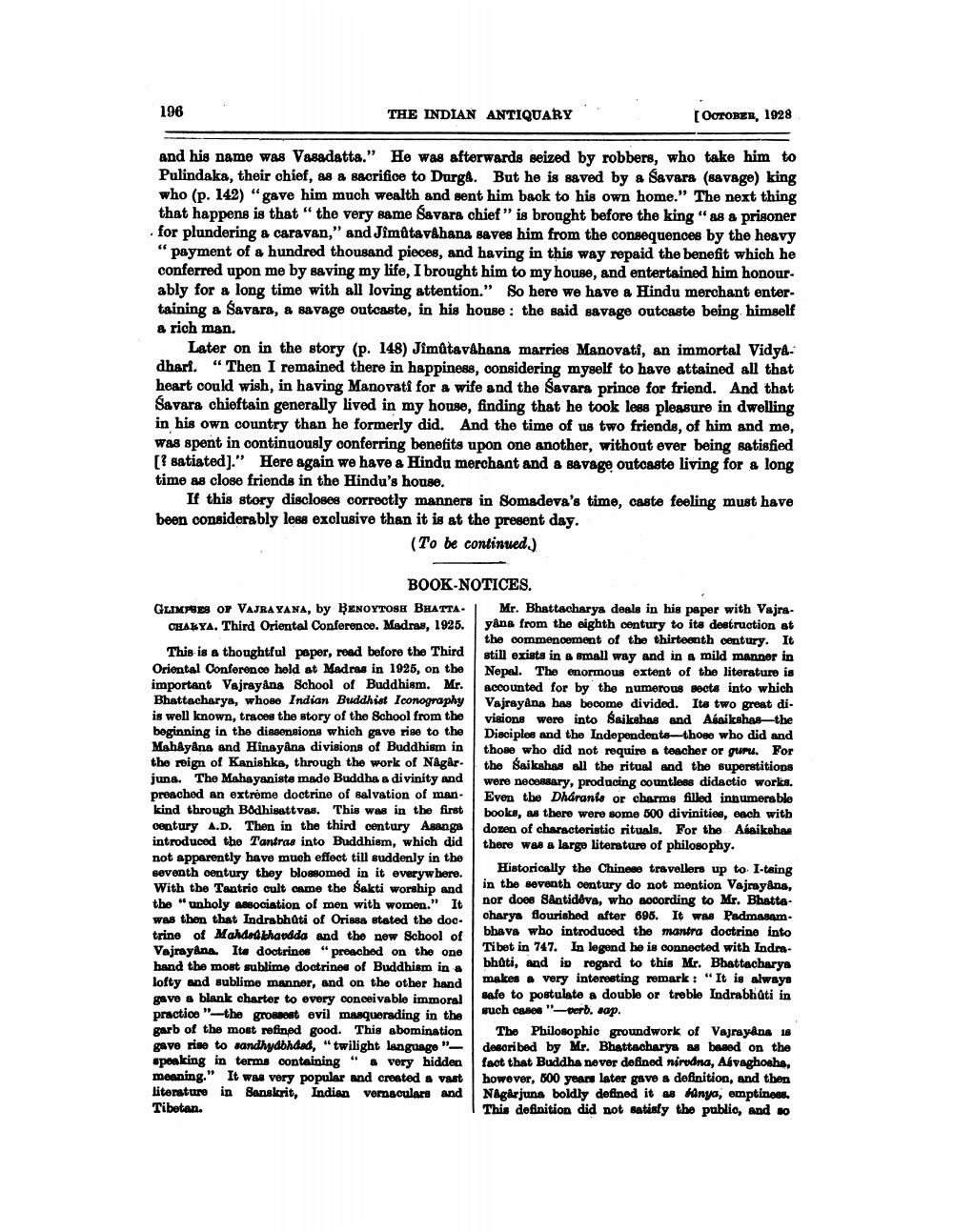________________
196
THE INDIAN ANTIQUARY
[OCTOBER, 1928
and his name was Vasadatta." He was afterwards seized by robbers, who take him to Pulindaka, their chief, as a sacrifice to Durg. But he is saved by a Savara (savage) king who (p. 142) "gave him much wealth and sent him back to his own home." The next thing that happens is that “the very bame Savara chief" is brought before the king "as a prisoner for plundering a caravan," and Jimataváhana saves him from the consequences by the heavy "payment of a hundred thousand pieces, and having in this way repaid the benefit which he conferred upon me by saving my life, I brought him to my house, and entertained him honourably for a long time with all loving attention." So here we have a Hindu merchant enter. taining & Savara, a savage outcaste, in his house: the said savage outcaste being himself a rich man.
Later on in the story (p. 148) Jimataváhans marries Manovati, an immortal Vidy. dhari. “Then I remained there in happiness, considering myself to have attained all that heart could wish, in having Manovati for a wife and the Savara prince for friend. And that Savara chieftain generally lived in my house, finding that he took less pleasure in dwelling in his own country than he formerly did. And the time of us two friends, of him and me, Was spent in continuously conferring benefits upon one another, without ever being satisfied [? satiated)." Here again we have a Hindu merchant and & Bavage outcaste living for a long time as close friends in the Hindu's house.
If this story discloses correctly manners in Somadeva's time, caste feeling must have been considerably less exclusive than it is at the present day.
(To be continued.)
BOOK-NOTICES. GLIMYOD OF VAJRA YANA, by BKNOYTOSH BHATTA | Mr. Bhattacharya deals in his paper with Vajra. CHAKYA. Third Oriental Conference. Madras, 1925. yana from the eighth century to its destruction at
the commencement of the thirteenth century. It This is a thoughtful paper, read before the Third
still exists in a small way and in a mild manner in Oriental Conference held at Madras in 1926, on the Nepal. The enormous extent of the literature is important Vajrayana School of Buddhism. Mr. accounted for by the numerous sects into which Bhattacharya, whose Indian Buddhist Iconography Vajrayana has become divided. Its two great diis well known, traces the story of the School from the visions were into Saikshas and Absikshas the beginning in the dissensions which gave rise to the Disciples and the Independents those who did and Mahayana and Hinay na divisions of Buddhism in
those who did not require a teacher or guru. For the reign of Kanishka, through the work of Någår. the Saikshas all the ritual and the superstitions juns. The Mahayanists made Buddha & divinity and
were necessary, producing countless didactic work. preached an extreme doctrine of salvation of man. Even the Dharanis or charms filled innumerable kind through Bodhisattvas. This was in the first
books, as there were some 500 divinitiee, each with century A.D. Then in the third century Aganga
dozen of characteristic rituals. For the Asaiksha introduced the Tantras into Buddhism, which did there was a large literature of philosophy. not apparently have much effect till suddenly in the seventh century they blossomed in it everywhere.
Historically the Chinese travellers up to I-tsing With the Tantrio cult came the Sakti worship and
in the seventh century do not mention Vajrayana, the "unholy association of men with women." It
nor does Santidéva, who according to Mr. Bhattawas then that Indrabhati of Orisss stated the doc
charya flourished after 695. It was Padmasamtrine of Mahdodhandda and the new School of
bhava who introduced the mantra doctrine into Vajrayana. Ita doctrines "preached on the one
Tibet in 747. In legend he is connected with Indrahand the most sublime doctrines of Buddhism in a
bhati, and in regard to this Mr. Bhattacharya lofty and sublime manner, and on the other hand
makes a very interesting remark: "It is always gave a blank charter to every conceivable immoral
safe to postulate a double or treble Indrabhati in practice the grossost evil masquerading in the
such cases"--Derb. sap. garb of the most refined good. This abomination The Philosophic groundwork of Vajrayana is gave rise to sandhyabhdad,"twilight language "- described by Mr. Bhattacharya as based on the speaking in terms containing " a very hidden fact that Buddha never defined nirudna, Asvaghosha, meaning." It was very popular and created a vast however, 600 years later gave a definition, and then literature in Sanskrit, Indian vernaculars and Nagarjuna boldly defined it es hinga, emptiness Tibetan.
This definition did not satisfy the publio, and so




